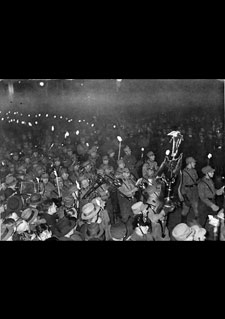The Nazi “Seizure of Power”
After the democratic and parliamentary constitutional Weimar Republic had been steadily undermined, Hitler assumed the chancellorship on January 30, 1933. The National Socialists shared responsibility for governing.
As of this day, Hitler headed a coalition government of so-called “national concentration”, in which only two other National Socialists other than he held government offices. The majority of government representatives had political ties to conservative parties.
The NSDAP’s strategists’ public celebration of this act as a “seizure of power” distorted the actual political situation of course: Rather than having been “seized”, the chancellorship had been surrendered to Hitler by President Paul von Hindenburg, at the inducement of von Papen’s intrigues, and the assumption of power could not be considered a completed process at this early stage.
A protracted and complex process to seize power commenced, which only concluded after eighteen months when Hitler assumed the office of President of Germany in the summer of 1934. Many saw the public celebration of the “seizure of power” by the NSDAP as a portent of the dawn of a new and better future for Germany.

